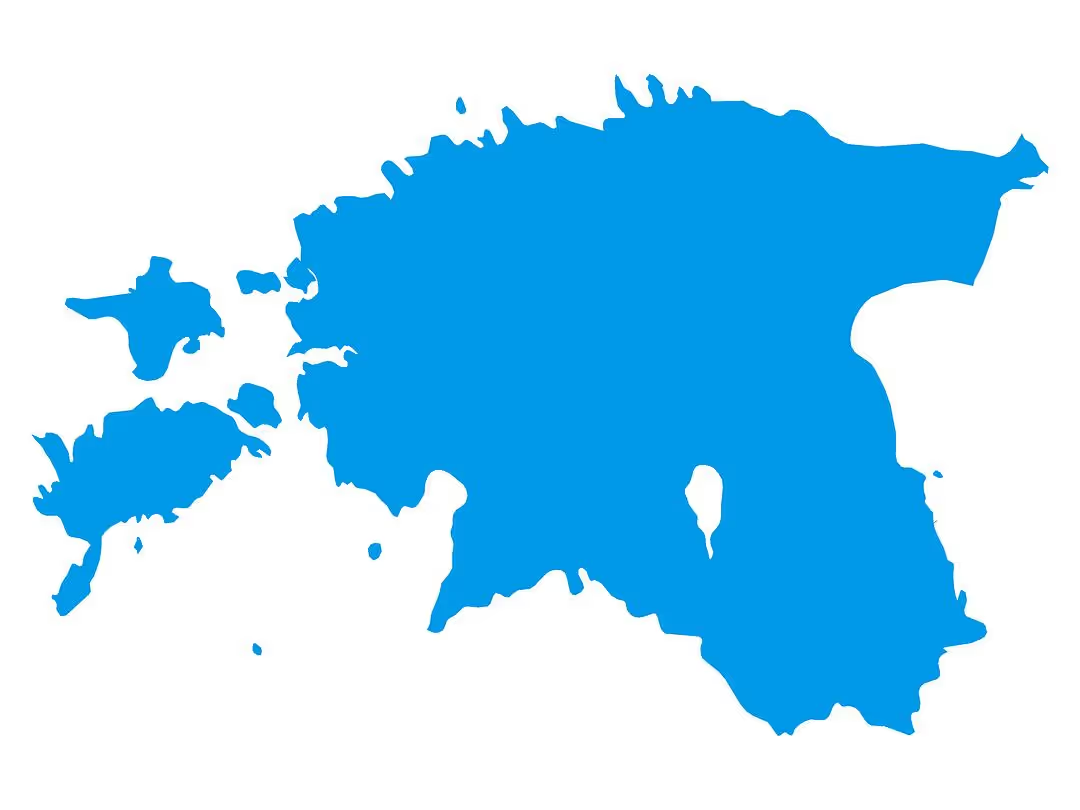

Employer of Record Guide in Estonia
Estonia's digital-first economy and tech-savvy workforce make it an attractive destination for global hiring, but navigating local employment laws and compliance requirements can be challenging. Our comprehensive guide helps you understand everything from payroll obligations to employment contracts, so you can hire Estonian talent with confidence.
Capital City
Currency
Languages
Population size
Services available in this country:

Key stats and facts
Estonia's thriving tech ecosystem centers around major hubs like Tallinn and Tartu, where skilled software developers and engineers drive innovation in one of Europe's most digitally advanced economies. With a flat 22% tax rate and strong demand for technical talent, Estonia offers compelling opportunities for companies looking to tap into Northern Europe's growing market.
Major economic hubs
Skills in demand
Currency
Language
GDP per Capita
Standard Tax Rate
Your EOR guide in Estonia
Understanding Estonia's employment landscape requires navigating everything from the country's unique flat tax system to comprehensive parental leave policies and strict GDPR compliance requirements. This detailed breakdown covers the essential employment regulations, compensation structures, and onboarding processes you need to hire compliantly in Estonia.
Minimum Wage
Estonia's minimum wage is €886 per month (€5.31 per hour), effective January 1, 2025. This represents an increase from €820 per month in 2024. Special rates apply to minors based on age, but there are no regional variations across the country.
Payroll Cycle
- Monthly: Required by law - wages must be paid at least once monthly on a predetermined payday specified in the employment contract
- Holiday Payment Rule: If payday falls on a public holiday or weekend, payment must be made on the preceding working day
Individual Income Tax
Estonia operates a flat tax system with a 22% rate (increased from 20% in 2024, effective January 1, 2025).
Tax-Free Allowances:
- General Taxpayers: Up to €654 per month (€7,848 annually)
- Income-Based Reduction: Allowance decreases as annual income increases; becomes zero for individuals earning above €25,200 annually
- Pensioners: Fixed basic exemption of €776 per month (€9,312 annually) for individuals of pensionable age
Tax Residency Criteria
Individuals are considered Estonian tax residents if they spend 183 days in Estonia within 12 consecutive calendar months or have a permanent place of residence in Estonia. Residents are taxed on worldwide income, while non-residents pay tax only on Estonian-sourced income.
Employer Payroll Contributions
Estonian employers face one of the highest payroll tax burdens in Europe:
| Contribution Type | Rate | Purpose |
|---|---|---|
| Social Tax | 33% | State pension (20%) + Public health insurance (13%) |
| Unemployment Insurance | 0.8% | Unemployment benefits |
| Total Employer Cost | 33.8% | Of employee's gross salary |
Note: Workers' compensation is covered under the social tax system with no separate contribution required.
Working Hours
The standard work schedule is 8 hours per day, 40 hours per week, typically distributed over 5 days. Estonia permits "summarised working time" arrangements where hours can be distributed unevenly across a reference period (usually 4 months) as long as the average doesn't exceed 40 hours per week.
The Employment Contracts Act is being updated to allow more flexible arrangements, including remote work by mutual agreement.
Overtime Pay
Employees can choose between two compensation options for overtime work:
- Paid time off equal to overtime hours worked, OR
- Overtime pay at minimum 1.5× regular wage rate
Maximum Limits:
- Average 48 hours per week over 4-month reference period (standard)
- Average 52 hours per week by separate agreement (employee can cancel with 2 weeks' notice)
Bonus Payments
Estonia doesn't require a mandatory 13th-month bonus. Annual performance-based bonuses are common but not mandatory unless specified in the contract or collective agreement. Performance bonuses are included in average wage calculations for final pay, vacation, and severance.
Full-Time vs. Part-Time
- Full-time: 40 hours per week
- Part-time: No specific statutory threshold; based on employer-employee agreement
- Benefits: Part-time employees are entitled to the same rights and benefits as full-time employees on a pro-rata basis
Vacation Leave
- Standard Entitlement: 28 calendar days annually (35 days for minors or those with partial/no work capacity)
- Accrual Rate: 2.33 days per month from the first day of employment
- Usage Eligibility: Can take leave after 6 months of employment
- Public Holiday Exclusion: Public holidays are not included in vacation count
- Vacation Pay:
- Fixed salary employees: Continue normal wage
- Variable pay employees: Based on average daily wage over preceding 6 months
- Payout Rules: All unused accrued vacation must be paid out upon termination
Sick Leave
- Duration: Up to 182 consecutive calendar days per year (240 days for tuberculosis)
- Payment Structure:
- Day 1: Unpaid
- Days 2-8: Employer pays 70% of average salary
- Day 9 onwards: Estonian Health Insurance Fund pays 70% of average salary
- Medical Certificate: Required for sick pay benefits
Maternity Leave
Note: Please verify this information - research shows conflicting data on duration (100 vs 140 days)
- Duration: 100 calendar days (can begin 31-70 days before due date)
- Payment: 100% of average earnings from previous calendar year (paid by Social Insurance Board)
- Job Protection: Guaranteed return to same position
Parental Leave
- Paternity Leave: 30 calendar days paid leave (usable from 30 days before due date until child turns 3)
- Shared Parental Leave: 475 days shared between parents (usable until child turns 3)
- Simultaneous Use: Both parents can take up to 60 days simultaneously
- Childcare Leave: 10 working days paid leave per parent per child until child reaches age 14
Bereavement Leave
Note: Please verify this information - research shows conflicting data on legal requirements vs typical practices
There is no specific legal mandate for paid bereavement leave in Estonia. Bereavement leave is subject to employer agreement and company policy.
Personal & Family Leave
- Carer's Leave: Up to 5 working days to care for family member or household member needing personal support (compensated at minimum wage rate)
- Study Leave: 30 calendar days annually for formal education or vocational training (20 days paid at average wage)
Summary
| Leave Type | Duration | Paid? | Funding |
|---|---|---|---|
| Vacation | 28 days/year | Yes | Employer |
| Sick Leave | Up to 182 days | 70% (after day 1) | Employer (days 2-8), Health Insurance Fund (day 9+) |
| Maternity Leave | 100 days | 100% | Social Insurance Board |
| Paternity Leave | 30 days | Yes | Social Insurance Board |
| Shared Parental Leave | 475 days | Yes | Social Insurance Board |
| Carer's Leave | 5 days | Minimum wage rate | Employer |
| Study Leave | 30 days (20 paid) | Partial | Employer |
Termination Types
With Cause (Extraordinary Cancellation):
- Valid reasons include significant breach of duties, long-term incapacity, or loss of trust
- Prior warning typically required for performance issues
- No notice or severance required
Without Cause (Redundancy/Lay-off):
- Economic reasons such as decreased work volume or reorganisation
- Specific procedures required with restrictions on terminating protected employees
- Notice and severance required
Constructive Dismissal:
- Employee can terminate without notice for significant employer breach (e.g., failure to pay wages)
- May receive compensation equivalent to 3 months' average wages
Notice Period Requirements
Notice periods are based on length of service:
| Length of Employment | Notice Period |
|---|---|
| Less than 1 year | 15 calendar days |
| 1-5 years | 30 calendar days |
| 5-10 years | 60 calendar days |
| More than 10 years | 90 calendar days |
Pay in Lieu: Required if employer provides less than statutory notice period.
Severance Pay
Note: Please verify this information - research shows conflicting data on calculation methods
- When Required: Mandatory in redundancy cases
- Calculation: One month's average salary from employer
- Additional Compensation: Estonian Unemployment Insurance Fund may provide additional compensation based on length of service
- Fixed-Term Contracts: If terminated due to redundancy, employee entitled to salary for remainder of contract term
Probationary Periods
- Maximum Length: 4 months
- Termination Notice: 15 calendar days notice required from either party during probation
- Rights: Full employee rights maintained during probation
Final Pay Requirements
All final payments must be made on the employee's last day of employment, including:
- Outstanding wages
- Accrued unused vacation compensation
- Applicable severance
- Other owed compensation
Termination Documents & Process
- Notice Format: Must be in format reproducible in writing (email acceptable)
- Content Requirements: Must clearly state legal grounds for termination
- Registration: Employer must de-register employee from Employment Register within 10 days
Anti-Discrimination & Retaliation Laws
Protected characteristics include gender, nationality, race, colour, language, origin, religion, political opinion, social status, age, disability, and sexual orientation. Termination due to pregnancy or exercising family leave rights is unlawful, as is termination for whistleblowing.
National Holidays
Estonia observes 12 official public holidays in 2025:
| Holiday | Date |
|---|---|
| New Year's Day | January 1 |
| Independence Day | February 24 |
| Good Friday | April 18 |
| Easter Sunday | April 20 |
| Spring Day | May 1 |
| Pentecost | June 8 |
| Victory Day | June 23 |
| Midsummer Day | June 24 |
| Day of Restoration of Independence | August 20 |
| Christmas Eve | December 24 |
| Christmas Day | December 25 |
| Boxing Day | December 26 |
Shortened Workdays
The workday preceding New Year's Day, Independence Day, Victory Day, and Christmas Eve must be shortened by 3 hours.
Regional Holidays
Estonia has no official regional public holidays.
Working on a Statutory Holiday
Employees who work on public holidays receive:
- Double pay (2×) for hours worked on public holidays, OR
- Additional paid time off by mutual agreement
Required Documents for Employment
- Employment Contract: Written contract mandatory, must be in Estonian unless both parties agree otherwise
- Identification: Valid passport or ID card required
- Work Authorisation: Non-EU/EEA citizens require valid work permit or visa
- Employment Register: Employer must register employee with Estonian Tax and Customs Board before work commences
- Banking Information: Required for salary payments
Language Requirements
- Official Language: Estonian
- Contract Language: Employment contracts and official documents must be in Estonian
- Business Practice: English is widely spoken, especially in the tech sector and international business
Background Checks & References
Background checks are permitted but strictly regulated by GDPR and the Personal Data Protection Act. Permissible checks include employment history, education, and criminal records (if legitimate interest or legal obligation exists). The legal basis is typically legal obligation or employer's legitimate interest rather than consent due to power imbalance.
Data Protection & Privacy
Estonia follows EU General Data Protection Regulation (GDPR) requirements, including:
- Clear legal basis for data collection and processing
- Employee notification about data processing
- Data security assurance
IP Assignment & Confidentiality
Economic rights to IP created by employees as part of their duties transfer to the employer unless the contract states otherwise. Recommended clauses include clear IP assignment, confidentiality obligations, and post-employment restrictions.
Non-Compete Agreements:
- Permissible but must be reasonable in scope, duration (typically up to 1 year), and geographical area
- Employer must pay separate monthly compensation during restriction period
Probation Period Setup
Up to 4 months can be included in the employment contract as a probationary period.
Onboarding Timeline (Sample)
| Step | Timeline |
|---|---|
| Job offer accepted | Day 0 |
| EOR contract issued to client | Day 1–2 |
| Employee signs employment contract (in Estonian) | Day 3–5 |
| Employment Register registration | Day 3–5 |
| Banking and tax setup | Day 5–7 |
| Onboarding package delivered | Day 7–10 |
What the EOR Handles
Borderless AI will handle:
- Estonian-language employment contracts
- Employment Register registration
- Local tax and social security compliance
- Payroll processing in euros
- GDPR compliance
- Local legal representation
Worker Classification: Employee vs Contractor
Estonian law presumes that individuals performing work for another person with expectation of payment are employees. Key employment indicators include subordination to employer's management and control, use of employer's tools, and regular remuneration.
Independent contractors operate with autonomy, bear their own business risks, and are responsible for their own taxes and social contributions. Misclassification penalties include retroactive payment of payroll taxes, social contributions, and employee benefits.
Unionisation & Collective Agreements
Employees have the right to form and join trade unions. Collective agreements can regulate employment conditions such as wages and working hours, often providing more favourable terms than statutory minimums.
Cultural Norms & DEI Expectations
Estonian workplace culture highly values work-life balance, with the 40-hour work week respected and flexible arrangements increasingly common. Communication style is direct, efficient, and solution-oriented, with a low-power-distance culture featuring relatively flat hierarchies.
As an EU member state, Estonia has a strong legal anti-discrimination framework. Employers are expected to foster inclusive environments and ensure equal opportunity.
Anti-Discrimination Laws
- Equal Treatment Act: Prohibits discrimination based on nationality, race, colour, religion, age, disability, and sexual orientation
- Gender Equality Act: Prohibits sex-based discrimination
- Accommodation Requirements: Employers must make reasonable accommodations for employees with disabilities
Remote Work Considerations
Estonia has no separate remote work law; Employment Contracts Act principles apply. Key considerations include:
- Contract Requirements: Work location (if remote) should be specified in employment contract
- Employer Obligations:
- Ensure safe and healthy working environment for remote workers
- Conduct risk assessments and provide ergonomics guidance
- Ensure equal treatment of remote and in-office staff
- Cross-Border Considerations: Working from another country creates significant tax and social security complexities requiring careful legal and tax analysis
- Digital Nomad Visa: Available for foreigners working remotely in Estonia for foreign employers
Built-in benefits packages for Estonia
When the world is your competition, it pays to incentivize new hires and existing alike. Borderless AI benefits packages typically inlucde:

Medical Insurance

Dental Insurance

Retirement Contribution

Life Insurance

Vision Insurance
Explore other countries

Unlock global hiring potential
Simplify your payroll and hiring processes today.








